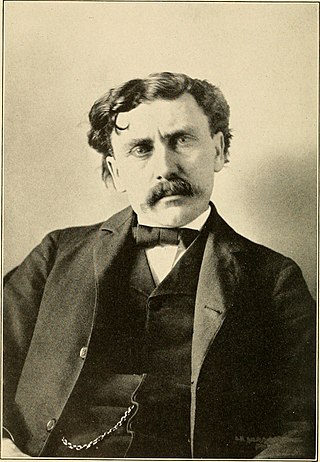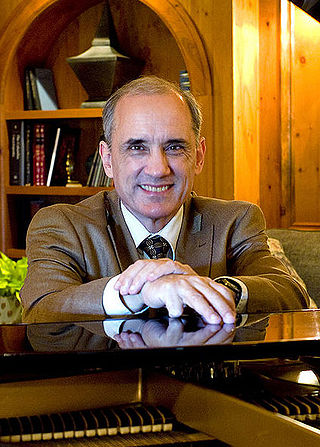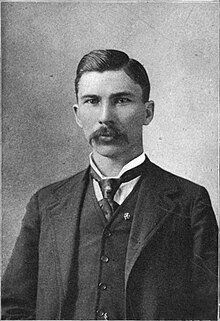
James Mooney was an American ethnographer who lived for several years among the Cherokee. Known as "The Indian Man", he conducted major studies of Southeastern Indians, as well as of tribes on the Great Plains. He did ethnographic studies of the Ghost Dance, a spiritual movement among various Native American culture groups, after Sitting Bull's death in 1890. His works on the Cherokee include The Sacred Formulas of the Cherokees (1891), and Myths of the Cherokee (1900). All were published by the US Bureau of American Ethnology, within the Smithsonian Institution.

The Lenape, also called the Lenni Lenape and Delaware people, are an indigenous people of the Northeastern Woodlands, who live in the United States and Canada.

Moses Edwin Clapp was an American lawyer and politician.

The Schuylkill River is a river running northwest to southeast in eastern Pennsylvania. The river was improved by navigations into the Schuylkill Canal, and several of its tributaries drain major parts of Pennsylvania's Coal Region. It flows for 135 miles (217 km) from Pottsville to Philadelphia, where it joins the Delaware River as one of its largest tributaries.

The Province of Pennsylvania, also known as the Pennsylvania Colony, was a British North American colony founded by William Penn, who received the land through a grant from Charles II of England in 1681. The name Pennsylvania was derived from "Penn's Woods", referring to William's father Admiral Sir William Penn.

Cuyahoga Valley National Park is an American national park that preserves and reclaims the rural landscape along the Cuyahoga River between Akron and Cleveland in Northeast Ohio.
Gelelemend (1737–1811) (Lenape), also known as Killbuck or John Killbuck Jr., was an important Delaware (Lenape) chief during the American Revolutionary War. He supported the rebel Americans, known as Patriots. His name signifies "a leader." He was born into the Turtle clan, which had hereditary responsibility for leadership, he became principal chief of the Lenape in November 1778, following the death of White Eyes, a war chief and Speaker of the Delaware Head Council. Gelelemend succeeded his maternal grandfather Netawatwees.

Richard Ghormley Eberhart was an American poet who published more than a dozen books of poetry and approximately twenty works in total. "Richard Eberhart emerged out of the 1930s as a modern stylist with romantic sensibilities." He won the Pulitzer Prize for Poetry for Selected Poems, 1930–1965 and the 1977 National Book Award for Poetry for Collected Poems, 1930–1976. He was the grandfather of Pittsburgh Pirates general manager Ben Cherington.
Americanist phonetic notation, also known as the North American Phonetic Alphabet (NAPA), the Americanist Phonetic Alphabet or the American Phonetic Alphabet (APA), is a system of phonetic notation originally developed by European and American anthropologists and language scientists for the phonetic and phonemic transcription of indigenous languages of the Americas and for languages of Europe. It is still commonly used by linguists working on, among others, Slavic, Uralic, Semitic languages and for the languages of the Caucasus, of India, and of much of Africa; however, Uralists commonly use a variant known as the Uralic Phonetic Alphabet.

Mary Campbell was an American colonial settler who was known for her abduction by Native Americans during the French and Indian War being the first white child to travel to the Western Reserve. Born in 1747 or 1748, Campbell was taken captive by the Lenape tribe at the age of ten in 1758. It is believed that she lived with the Lenape, possibly under the care of their chief Netawatwees, in locations near Cuyahoga Falls, Ohio, and Newcomerstown, eastern Ohio. Campbell's return to her family in Pennsylvania in 1764 was facilitated by British military pressure on the Native Americans. She was among a group of captives released to British forces and transported to Fort Pitt.

The Christian Munsee are a group of Lenape, an Indigenous people in the United States, that primarily speak Munsee and have converted to Christianity, following the teachings of Moravian missionaries. The Christian Munsee are also known as the Moravian Munsee or the Moravian Indians, the Moravian Christian Indians or, in context, simply the Christian Indians. As the Moravian Church transferred some of their missions to other Christian denominations, such as the Methodists, Christian Munsee today belong to the Moravian Church, Methodist Church, United Church of Canada, among other Christian denominations.

Daniel Edwin Barker is an American atheist activist and musician who served as an evangelical Christian preacher and composer for 19 years but left Christianity in 1984. He and his wife Annie Laurie Gaylor are the current co-presidents of the Freedom From Religion Foundation, and he is cofounder of The Clergy Project. He has written numerous articles for Freethought Today, an American freethought newspaper. He is the author of several books including Losing Faith in Faith: From Preacher to Atheist.
Nationality words link to articles with information on the nation's poetry or literature.

Anthony Francis Clarke Wallace was a Canadian-American anthropologist who specialized in Native American cultures, especially the Iroquois. His research expressed an interest in the intersection of cultural anthropology and psychology. He was famous for the theory of revitalization movements.
John Campanius, also known as Johan Campanius and Johannes Campanius, was a Swedish Lutheran priest assigned to the New Sweden colony.
Unami Lodge, One is the Order of the Arrow (OA) lodge of the Cradle of Liberty Council, Boy Scouts of America (BSA) and the founding Lodge of the OA, having celebrated its centennial in 2015. The current Unami Lodge resulted from the 1996 merger of Unami Lodge 1 and Delmont Lodge 43, caused by the merger of Philadelphia Council and Valley Forge Council. The chiefs of each lodge agreed to preserve Unami's rich history and traditions by retaining the founding lodge's name and number. Delmont Lodge's history, including its roster of Vigil Honor, Founder's Award, and David Fortunato Outstanding Service Award recipients, is preserved as part of Unami Lodge's history. The lodge's totem is the turtle, reflecting both the name of the animal (unami) in the Delaware language, but also its association with its peoples.

Delaware State Park is a 1,686-acre (682 ha) public recreation area on U.S. Route 23 near the city of Delaware in Delaware County, Ohio, in the United States. It is open for year-round recreation including camping, hiking, boating, hunting, fishing, and picnicking.
Alluwe is a ghost town in Nowata County, Oklahoma. The post office was established as Lightening Creek on October 23, 1872, after the namesake waterway. On June 27, 1883, the town was renamed Alluwe. The post office existed under this new name until July 31, 1909.
Hell Town is the name for a Lenape Native-American village located on Clear Creek near the abandoned town of Newville, in the U.S. state of Ohio. The site is on a high hill just north of the junction of Clear Creek and the Black Fork of the Mohican River.
Tom Hill (1811–1860) was a Lenape mountain man active in the American frontier. He first became prominent in the service of Kit Carson as a fur trapper during the 1830s. After that, he lived among the Nimíipuu, influencing them to mistrust ABCFM missionaries. Throughout 1847, Hill was In Alta California fighting in the service of John C. Frémont. Tom Hill returned to Kansas in 1854 to live among fellow Lenape, where he died in 1860. Several later historians have named Hill as the primary cause of the Whitman Massacre, earning him some notoriety.













